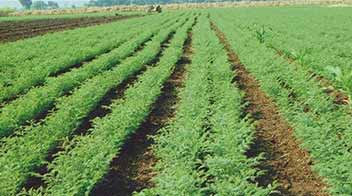
Advisory ArticleAgroStar Agronomy Centre of Excellence
Water Management of Gram Crop
Gram is an important crop among the crops taken during Rabbi season. Many farmers take the advantage of the rains of Hasta Nakshatra and sow the gram crop and obtain more yield.To get more yield of the gram crop, present article on water management will be definitely beneficial.
In case, moisture in the soil is very less in the field where gram crop has been sowed and if it is possible to provide one time water then water is to be given at the flowering stage of the gram crop. In irrigated farming, while building up soil, space between the two furrows should be kept minimum and length should also kept less according to the slope of the field. In the medium soil, first watering should be done after 20 to 25 days, second watering to be given after 45 to 50 days and third watering to be given after 65 to 70 days.In the heavy soil only two times water supply is sufficient. First watering should be given after 30 to 35 days and second after 60 to 65 days.For gram crop, approximately 25 centimeter of water is required. It is necessary to give each watering appropriately. Excess watering may spoil the crop. As per the depth of the field, periodical gap should be maintained between two watering to the field. One time watering of the crop increases yield by 30 percent, watering twice will increase yield by 60 percent and watering three times doubles the yield.
Drip irrigation -
Gram crop yield increases considerably on watering by the method of sprinkler irrigation. Gram crop is very sensitive to the water and excessive watering spoils the crop, hence sprinkler irrigation is a quite appropriate method of watering to the gram crop. By this method only sufficient water can be given to the crop. This results in less weed in the crop, too. Controlled watering can be done with the help of sprinkler irrigation which saves the future loss of the crop due to the root rot disease.
Agrostar Agronomy Center Excellence, 2nd November 17
298
2

